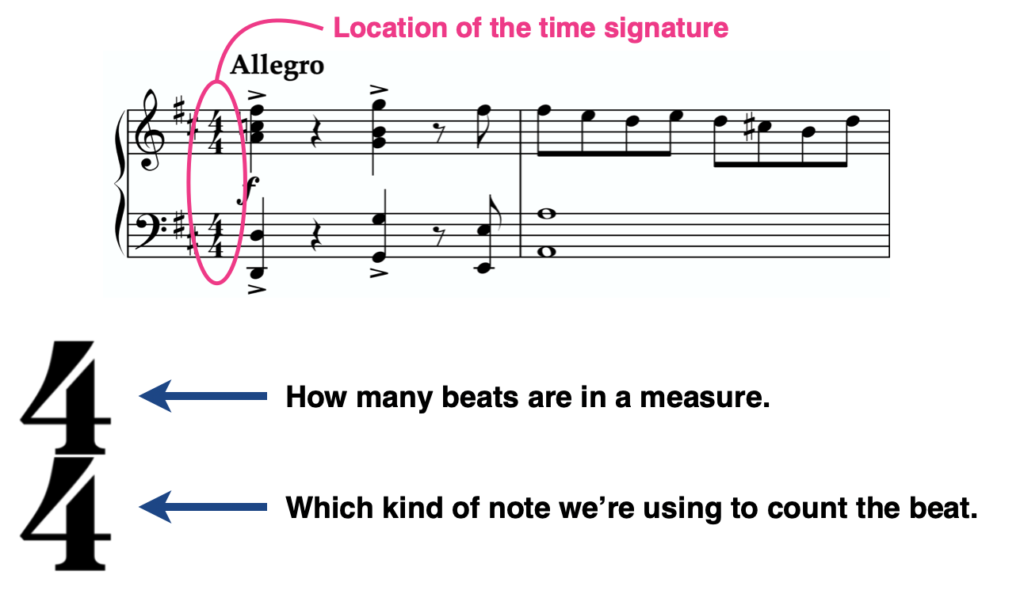
As far as music time signatures go, you’ve probably seen a lot of 4/4, and a lot of 3/4, but have you ever seen a 6/8 time signature? 6/8 is a compound time signature that conveys a feeling of two, but has 6 beats per measure.
Want to know how it works? Keep reading to find out.
Review: What's a time signature again?
Remember that a time signature is a way of organizing the beats (or, the “pulse”) in music. Time signatures break down musical beats so that they can more easily be counted using measures.
Time signatures are typically found at the beginning of a piece of music, and consist of two numbers, one on top of the other:

When describing a time signature, we state how many beats there are per measure, and what kind of note value “gets” (i.e., is be used to count) the beat. For example, when describing the 4/4 time signature above, we would say, “there are 4 beats per measure, and the quarter note gets the beat.”
For a more detailed look at time signatures, check out our article, Understanding Time Signatures and Meters: A Musical Guide.
What is a 6/8 time signature?
Time signatures like 4/4 and 3/4 are known as simple meters, meaning that they are counted and “felt” very simply, one pulse to one count.
6/8 is what’s known as a compound meter. In a compound meter, we feel the pulse of the music in larger groupings of three notes, even though we count each of those notes as a beat. This means that we feel the pulse of 6/8 in two, with three beats filling in (or subdividing) the space between the pulses.
So what’s the difference between 3/4 and 6/8? Here are notated versions of 3/4 and 6/8 next to each other, with both their beats and pulse groupings labeled:

As you can see, when in 3/4 we feel each of the beats as a pulse, but in 6/8 we only feel two pulses, each with three beats in between them. Because of this, 6/8 is usually used for slightly faster music, as it becomes easy to feel the pulse of slower tempos as 3/4.
Why not just use 2/4?
If we feel 6/8 in pulses of 2, why not just use a two-pulse (duple) meter like 2/4?
Once again, it comes down to the “feel” of the beat.
In 2/4, we feel the pulse once every quarter note beat, but the beats are divided into two eighth notes. In 6/8, we also feel the pulse once per quarter note, but the beats subdivide the pulses into three eighth notes.
Here is what 2/4 and 6/8 look like with their pulses lined up:

Music that uses 2/4 instead of 6/8 tends to have a more “straight” or march-type feel.
Music that uses 6/8 tends to have a more jaunty or dance-like lilt, or can have a “rolling” feel. 6/8 is a commonly interpreted time signature for a great deal of western European folk music, and composers have traditionally used 6/8 when trying to evoke a feel of the pastoral countryside, or of folk songs.
Examples of 6/8
Because of the three-note groupings of beats, a very common rhythm seen in 6/8 is the quarter note to an eighth note:

Another characteristic rhythm of 6/8 is the dotted-quarter note, which contains all of the eighth notes of one 3-beat grouping:

Additionally, because an eighth note can be broken down into two 16th notes, a single 6/8 pulse contains six 16th notes (for a total of twelve in a single 6/8 measure):

6/8 is frequently used in melodies for children’s rhymes:



Beethoven used it in the last movement of his sixth symphony (known as the “Pastorale” symphony), and named the movement “Shepherd's Song…”

6/8 has also found its way into pop and rock music:
Thanks for checking out this article from Liberty Park Music! If you liked what you saw here, you can find more in our blog at libertyparkmusic.com. We also have a YouTube page! And if you're really ready to take your music training to the next level you can subscribe to our site and gain access to a full spectrum of piano, guitar, drum, and music theory lessons.
Sign up for our free newsletter
Useful articles for musicians
About the Author: West Troiano
West has over 10 years of teaching experience in settings that vary from private studios to college classrooms. In addition to teaching through traditional forms of piano pedagogy, West frequently produces music and teaching materials that cater to the needs of his students. Check out West's course on Piano Etudes for both beginners and intermediate pianists.







